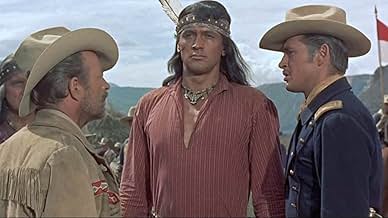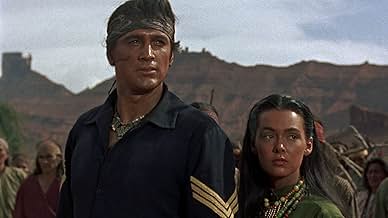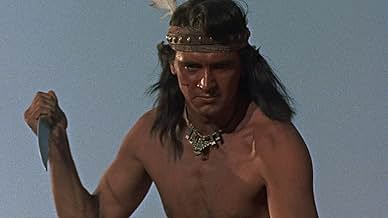IMDb-BEWERTUNG
5,6/10
1126
IHRE BEWERTUNG
Als der friedensstiftende Apache-Häuptling Cochise stirbt, sind die Chiricahua-Apachen hin- und hergerissen, ob sie Cochises friedliebendem Sohn Taza oder dem streitbaren abtrünnigen Apache-... Alles lesenAls der friedensstiftende Apache-Häuptling Cochise stirbt, sind die Chiricahua-Apachen hin- und hergerissen, ob sie Cochises friedliebendem Sohn Taza oder dem streitbaren abtrünnigen Apache-Krieger Geronimo folgen sollen.Als der friedensstiftende Apache-Häuptling Cochise stirbt, sind die Chiricahua-Apachen hin- und hergerissen, ob sie Cochises friedliebendem Sohn Taza oder dem streitbaren abtrünnigen Apache-Krieger Geronimo folgen sollen.
Rex Reason
- Naiche
- (as Bart Roberts)
Eugene Iglesias
- Chato
- (as Gene Iglesias)
Richard H. Cutting
- Cy Hegan
- (as Richard Cutting)
Bradford Jackson
- Lt. Richards
- (as Brad Jackson)
Seth Bigman
- Indian Man
- (Nicht genannt)
Empfohlene Bewertungen
Taza, Son of Cochise is directed by Douglas Sirk and written by Gerald Drayson Adams and George Zuckerman. It stars Rock Hudson, Barbara Rush, Gregg Palmer, Rex Reason and Morris Ankrum. A Technicolor production with the Music scored by Frank Skinner and cinematography by Russell Metty.
In 1872 the long bitter war fought between the United States Cavalry troops and Apache bands led by Cochise came to an end. The peace treaty signed by Cochise and General Howard brought peace to the Arizona Territory. But three years later the mighty leader of the Chiricahua Apaches grew ill and come to the end of his days....
....the torch was passed to his first born son, Taza, who wants to follows his father's ideals and peace brokering ways. His second born son, Naiche, however, has different ideas, as does the mighty Geronimo.....
Douglas Sirk's only venture into the Western realm was originally shot in 3D around the gorgeous Arches National Monument Park. Following the pro-Indian theme that was becoming a feature of 1950s Westerns, it's a film that suffers primarily because of the casting of none Native Americans in the important character roles. Which is a shame because it's a gorgeous production that features action scenes full of vim and vigour. Story isn't out of the ordinary and the dialogue is often clunky as the Indian chatter is of the Hollywoodisation kind. Yet picture is never dull, the interest is always held as Taza attempts to hold on to peace for his people, whilst simultaneously he's trying to court the hand of Oona (Rush) against the wishes of her father, the war mongering Grey Eagle (Ankrum).
Hudson, badly cast as he is, can't be faulted for commitment in the title role. He clearly feels at ease working for Sirk (it was a coupling that would work together on a total of 9 movies), and at least he has the physicality for such a character. Unlike Ian MacDonald as Geronimo, who looks too old, is too staid and sticks out like a sore thumb. Russell Metty's photography is top draw, both in capturing gorgeous frames of the locale and in choice of colour lenses. Skinner provides a breezy, if standard Indian tinted Western musical score, and Sirk's direction is simple and effective with only minimal 3D moments part of the action. It's hardly an essential picture in the pantheon of pro-Indian Westerns, but it's better than it has a right to be, and with Pegasus' DVD release providing a lovely print, this is worth seeking out if only for Russell Metty's fine work. 6.5/10
In 1872 the long bitter war fought between the United States Cavalry troops and Apache bands led by Cochise came to an end. The peace treaty signed by Cochise and General Howard brought peace to the Arizona Territory. But three years later the mighty leader of the Chiricahua Apaches grew ill and come to the end of his days....
....the torch was passed to his first born son, Taza, who wants to follows his father's ideals and peace brokering ways. His second born son, Naiche, however, has different ideas, as does the mighty Geronimo.....
Douglas Sirk's only venture into the Western realm was originally shot in 3D around the gorgeous Arches National Monument Park. Following the pro-Indian theme that was becoming a feature of 1950s Westerns, it's a film that suffers primarily because of the casting of none Native Americans in the important character roles. Which is a shame because it's a gorgeous production that features action scenes full of vim and vigour. Story isn't out of the ordinary and the dialogue is often clunky as the Indian chatter is of the Hollywoodisation kind. Yet picture is never dull, the interest is always held as Taza attempts to hold on to peace for his people, whilst simultaneously he's trying to court the hand of Oona (Rush) against the wishes of her father, the war mongering Grey Eagle (Ankrum).
Hudson, badly cast as he is, can't be faulted for commitment in the title role. He clearly feels at ease working for Sirk (it was a coupling that would work together on a total of 9 movies), and at least he has the physicality for such a character. Unlike Ian MacDonald as Geronimo, who looks too old, is too staid and sticks out like a sore thumb. Russell Metty's photography is top draw, both in capturing gorgeous frames of the locale and in choice of colour lenses. Skinner provides a breezy, if standard Indian tinted Western musical score, and Sirk's direction is simple and effective with only minimal 3D moments part of the action. It's hardly an essential picture in the pantheon of pro-Indian Westerns, but it's better than it has a right to be, and with Pegasus' DVD release providing a lovely print, this is worth seeking out if only for Russell Metty's fine work. 6.5/10
Universal joined the parade of film studios that wanted to cash in on the popularity of Indian chiefs during the 1950s. This western followed the familiar formula of war and peace, reservation vs. warpath story lines, trigger happy soldiers and renegade Indians. Rock Hudson stars as the obedient, peace-loving son of Cochise in this Arizona saga but his brother opposes the chief's death-bed wish and schemes with other Indians to break free to raid and plunder. That is essentially the plot here, with nothing new to offer fans of this genre. The movie has enough action and scenic vistas to maintain interest but also looks like it was filmed on a shoestring budget. Hudson and Barbara Rush make a fetching couple and the supporting cast is good but the film lacks the polish of other Universal westerns of this period.
Don't get me wrong.I've always been a big fan of Deltlef Sierck (Douglas Sirk in America)and most of his melodramas are among my all time favorites : "A time to live and a time to die ","All that Heaven allows" "Magnificent obsession" " Tarnished angels" "Written on the wind" plus those with Zarah Leander in Germany not to forget his final effort ,the remake of "imitation of life".
THis remake was drastically different from Stahl's version:the black servant Delilah became Annie and the only thing she could expect in life was a beautiful funeral.In Stahl's version (and in Fannie Hurst's novel) she was a businesswoman's associate ,in Sirk's screenplay she stayed the good servant -not very far away from GWTW's Mamma-who knew her place.
Still with me?I do think that,in spite of Sirk's storyteller qualities and good scenes (the discovery of the bruises on Barbara Rush's back),"Taza" is also a reactionary work .Taza (who in real life died of pneumonia two years after his dad)predates Annie in "Imitation" :he is the good Indian,who knows his place ,who (this is amazing) dresses like them ,who rebels against his people's customs and even fights them;on the other hand ,Geronimo (and his allies) plays the role of the villain : "we were hunters, warriors,we won't be breeders ".After all ,the white men are taking their land and sending them to reservations:his rebellion makes sense.
Rock Hudson,who was Sirk's favorite actor (his best parts were certainly "All that Heaven allows" and "Magnificent Obsession" -another remake of a Stahl's work-) ,is not well cast as an Indian.And what about Barbara Rush as a squaw?Debra Paget was acceptable ("Broken Arrow"),she is not.
THis remake was drastically different from Stahl's version:the black servant Delilah became Annie and the only thing she could expect in life was a beautiful funeral.In Stahl's version (and in Fannie Hurst's novel) she was a businesswoman's associate ,in Sirk's screenplay she stayed the good servant -not very far away from GWTW's Mamma-who knew her place.
Still with me?I do think that,in spite of Sirk's storyteller qualities and good scenes (the discovery of the bruises on Barbara Rush's back),"Taza" is also a reactionary work .Taza (who in real life died of pneumonia two years after his dad)predates Annie in "Imitation" :he is the good Indian,who knows his place ,who (this is amazing) dresses like them ,who rebels against his people's customs and even fights them;on the other hand ,Geronimo (and his allies) plays the role of the villain : "we were hunters, warriors,we won't be breeders ".After all ,the white men are taking their land and sending them to reservations:his rebellion makes sense.
Rock Hudson,who was Sirk's favorite actor (his best parts were certainly "All that Heaven allows" and "Magnificent Obsession" -another remake of a Stahl's work-) ,is not well cast as an Indian.And what about Barbara Rush as a squaw?Debra Paget was acceptable ("Broken Arrow"),she is not.
One might have expected a lot more from Douglas Sirk in this, his single Western. Beautifully shot by Russell Metty who worked extensively with Sirk, it's a very routine Western of no great interest.
Before Sirk hit his stride with the great melodramas he tried his hand at light romantic comedy and costume drama with pleasing if not spectacular results. He brought little if anything at all to the Western.
Perhaps more than anything it's an important rung in the ladder of elevating Rock Hudson towards stardom which would come with Sirk's next film "Magnificent Obsession".
Hudson is adequate in the role, but that's hardly difficult amongst some truly wooden performances. All in all something of a low point in the amazing 50's career of Douglas Sirk.
Before Sirk hit his stride with the great melodramas he tried his hand at light romantic comedy and costume drama with pleasing if not spectacular results. He brought little if anything at all to the Western.
Perhaps more than anything it's an important rung in the ladder of elevating Rock Hudson towards stardom which would come with Sirk's next film "Magnificent Obsession".
Hudson is adequate in the role, but that's hardly difficult amongst some truly wooden performances. All in all something of a low point in the amazing 50's career of Douglas Sirk.
Beware folks, because you deal here with the only western that director Douglas Sirk will ever give to us. But he has for this western his fetish actor Rock Hudson, so he is not totally alone in unknown territory. This is an agreeable piece of work, not worse nor better than other Universal westerns of this period. George Sherman could have done it too, and in the very same manner. By chance, Jeff Chandler, who played Cochise in THE BROKEN ARROW - for Twentieth Century Fox - was in the meantime "transfered" to Universal Studios, so it was easy for the production to use him as a dying Cochise in the beginning. And this is not a spoiler !!!!! Rock Hudson is OK, it also could have been worse. Good western.
Wusstest du schon
- WissenswertesDouglas Sirk often cited this film as the favorite of his own films since he always wanted to make a Western.
- PatzerThe official U.S. flag of 1872, the year the story takes place, did have 37 stars in five rows, however it consisted of a top and bottom row of eight stars with three rows of seven stars in between (8-7-7-7-8), not alternating rows of seven and eight (7-8-7-8-7) as the one in the film has.
- VerbindungenFeatured in Rock Hudson's Home Movies - Demontage einer Kinolüge (1992)
Top-Auswahl
Melde dich zum Bewerten an und greife auf die Watchlist für personalisierte Empfehlungen zu.
- How long is Taza, Son of Cochise?Powered by Alexa
Details
- Erscheinungsdatum
- Herkunftsland
- Sprachen
- Auch bekannt als
- Taza, Son of Cochise
- Drehorte
- Devils Garden, Arches National Park, Utah, USA(cavalry ambush scene)
- Produktionsfirma
- Weitere beteiligte Unternehmen bei IMDbPro anzeigen
- Laufzeit1 Stunde 19 Minuten
- Seitenverhältnis
- 2.00 : 1
Zu dieser Seite beitragen
Bearbeitung vorschlagen oder fehlenden Inhalt hinzufügen

Oberste Lücke
By what name was Taza, der Sohn des Cochise (1954) officially released in India in English?
Antwort


































